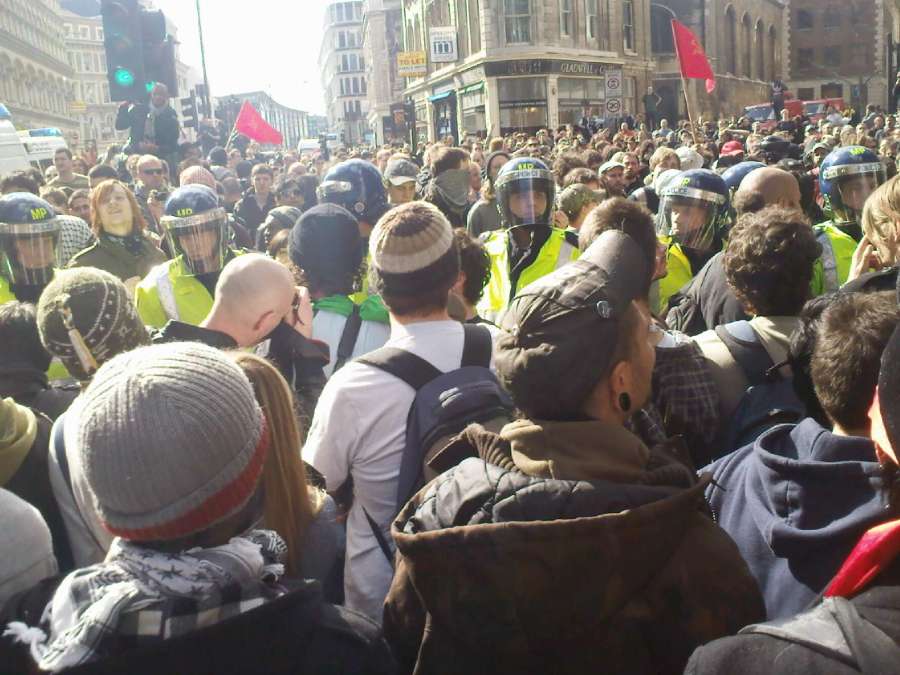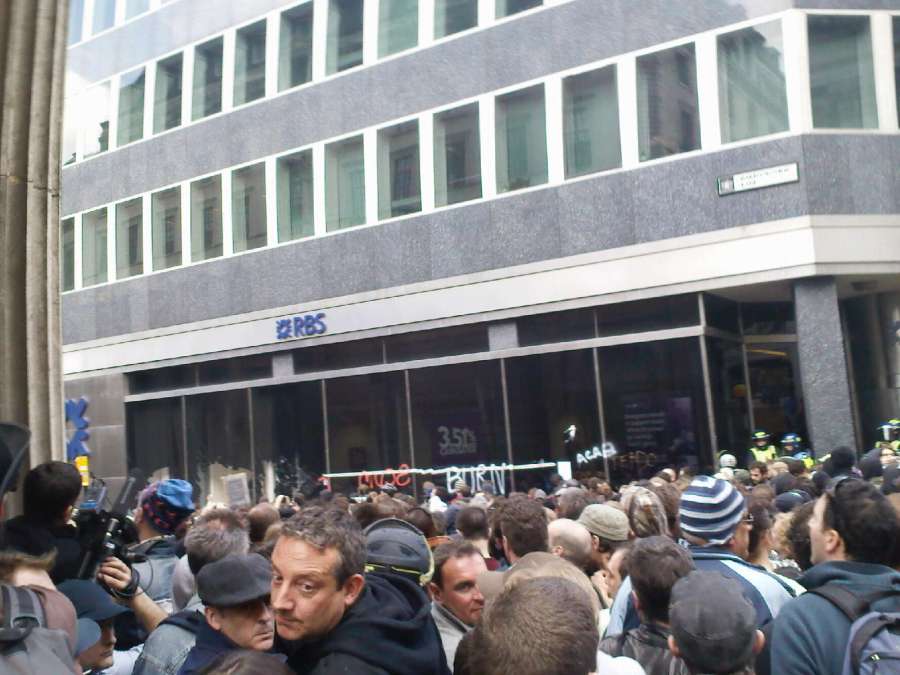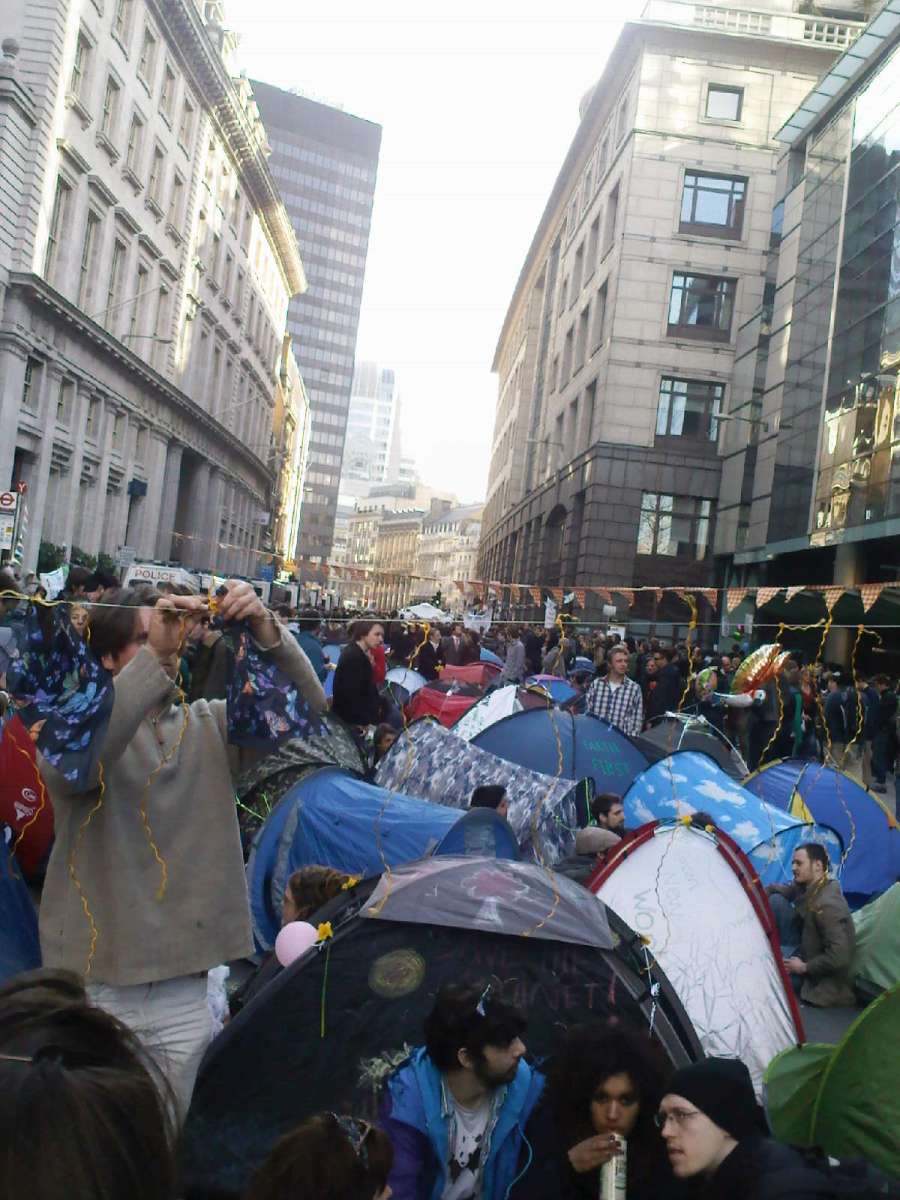Today the capital saw a mass march on the City of London, with contingents from four stations around the Square Mile – representing the four horsemen of the apocalypse threatening the system (war; climate change; job losses and the capitalist crisis; lack of housing) – converging at the Bank of England. The numbers at this demonstration, held to coincide with this week’s G20 summit hosted by Gordon Brown, were far greater than those at the SWP-organised “March on the City” and Chris Knight’s “Dancing on the grave of capitalism” event held last October at the peak of the financial meltdown.
Even the Tory Evening Standard reported that there were 4,000 people at the Bank of England, and certainly the protest’s numbers were large for a weekday. However, the demo, as well as the Climate Camp, were tightly contained by the police via a system of ‘kettles’ with 5,000 police, horses and police vehicles on hand to encircle groups of protestors. All in all there were 63 arrests: and late in the evening we heard that a man had died as the police besieged the demonstrators from all sides.
Much unlike Saturday’s turgid march organised by the otherwise lethargic Trades Union Congress and some liberal NGOs, the protests in the City of London were of an anti-capitalist character, mostly animated by anarchists. However, in the recent furore about today’s “G20 Meltdown” the media has greatly puffed up the importance of Chris Knight, the radical anthropologist suspended from his University of East London post for saying that people were so angry that bankers might be hanged from lamp-posts
Photos and a few comments on the events appear below. Besides the events described and depicted in this article, the day also saw a Stop the War rally from the US embassy to the Excel Centre.
The march started from the four corners of the Square Mile; activists assembled at Cannon Street Station in the morning to raise the issue of land and housing.
One of the ‘four horsemen of the apocalypse’ created by Chris Knight. Although these did not prove much of a focal point, the Evening Standard boards last week devoted great attention to the professor, while the Telegraph salaciously reported on the “dingy pub cellar meeting” where he supposedly orchestrated today’s events. Of course, most people came of their own accord – with their own views – and would not want to be tarred with the same brush as “Prof Knight, who believes the world will abolish international borders and become a single country by June of this year, [and] often went off on baffling tangents, at one point calling for the Bank of England to be converted into a state-run brothel”.
Several thousand people gathered in the square in front of the Bank of England, where most shop-windows had been boarded up. The atmosphere was rather flat, with few chants. There were few left groups with much of a presence or people selling papers.
Slogans ranged from the imaginative…

… to the bizarre.
The crowd got most animated during an assault on the Royal Bank of Scotland building on Threadneedle Street, which was – surprisingly – unprotected with wooden boards like most shopfronts. Activists smashed windows (a feat later replicated at HSBC), graffitied the bank and threw some of the computers around. We chanted “Whose streets? Our streets?”; “One solution – revolution” and “No justice, no peace, fuck the police!” as we were driven away by cops on horseback.

However, between noon and 3pm the mass of protestors was surrounded on all sides by the mass of riot police. A few people threw smoke bombs, cans and bottles, but the protest was far from violent and the atmosphere was not as ‘angry’ as it might have been.
Climate Camp set up along a street in Bishopsgate, with several hundred people. There were workshops throughout the day, but the event was soon surrounded by several lines of police at both ends. Simultaneously the police had set up a number of cordons around the Bank and Liverpool Street area. One man within the police cordon died in the early evening, the police claiming that he had just collapsed. Given their rough treatment of protestors, this is a highly dubious assertion.
Despite the lack of toilet facilities (other than up against the tyre of a police van…) the police would not allow anyone to leave for hours.Many of the most vocal Climate Camp organisers continually appealed to us not to resist the police, and a common theme was that we were there for a peaceful protest, not to protest against the police (speak for yourself…) When we finally were allowed to leave, it was only as a trickle of people, and several were taken aside and arrested – one of our affinity group trying to help someone was punched in the face by a police medic. News sources like the BBC and Guardian quoted people who distanced their own ‘reasonable’ behaviour from the antics of others worthy of police attention.







good report, hope to read more.
LikeLike
Wasn’t the dead man closer to Bank?
Also, interesting tidbit about the police medics getting violent. This was also reported on London IMC earlier in the day.
LikeLike
I dunno; to me this was the most violent protest I have ever seen in the UK. The cat and mouse street battles between police and protestors that spread to London Bridge (7-8PM) were almost spectacular. At one point a group of anarchists set up a barricade in the street and set it on fire. The police were all over the place.
LikeLike
I don’t think the scenes in London over the last couple of days have been particularly violent, you’ll see similar scenes and worse at a lot of football games in the average season.
LikeLike
This is utter shite. The man who died did so from natural causes, so the death and the so-called “clamp down” are completely unconnected, which is not what is implied.
Also, to advocate attacking the police (violently) is wrong and illegal. I do hope they arrest the writer of this for inciting and advocating acts of criminal damage and rioting/violence against the police. Shame on you for distorting the facts!
LikeLike
Bob, while not pre-empting further details that may emerge, it is at least a possibility that the police’s (unjustified and arguably illegal) use of ”kettles” to control people engaged in entirely peaceful protest – denying them access to water, toilet facilities and the quickest possible medical assistance – was a factor in the man’s death.
From the Guardian today: ”Photographs taken around 7.20pm show Tomlinson lying and sitting on the pavement about 200ft from where he collapsed. He had one arm in the air, and appeared to be in discussion with five riot police.”
Was he asking to be let out of the kettle? On what grounds was he refused? This is absolutely connected to the issue of police tactics and behaviour this week…
LikeLike
In any case, the police are the armed wing of the state and in a time of crisis their defense of the system does make them a target; whether involved in incitement, or not. It is an age old truth that totalitarian demagogues have tried to erase this uncomfortable fact with the tactic of ‘arrest them all’; further provoking the cycle of violence and distrust.
LikeLike
I went along on Saturday to the demo called to mark the dead man (Ian Tomlinson)’s death, with about 150 people marching from Bank to Bethnal Green police station.
It demanded an open public inquiry into his death (rather than just a police internal thing) and indeed in the last few days a number of papers have reported that witnesses saw him being struck on the head by police and then landing hard on the pavement.
LikeLike
I also met a guy a few days ago planning another protest against police tactics. I think this is valid and that the banning of the kettling technique would be significant.
LikeLike
George Monbiot has written an interesting blog piece about police attidues at the G20 protests (“Riot police, or rioting police?” http://tinyurl.com/cnvwjc).
I was there on Wednesday and didn’t witness any violence first-hand although the police did tell us we might be able to find a way out of the Square Mile via Threadneedle Street – meaning we got caught up in the huge rally where people started smashing up RBS.
I know police have a job to do but there’s no doubt tensions were getting frayed as the cordons tightened.
Makes you wonder why they decided to fence a load of protesters in around the (unprotected) bank??
LikeLike
http://www.guardian.co.uk/uk/video/2009/apr/07/g20-police-assault-video
Video on Guardian site
LikeLike